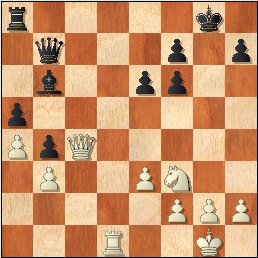
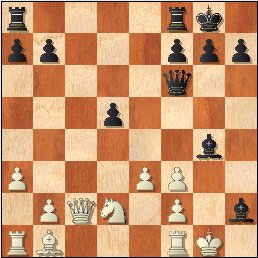
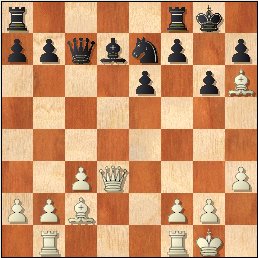
Improve your Chess via Active Learning
ACTIVE LEARNING is any strategy that involves students in doing things and thinking about the things they are doing (*)
You could study the following material either by skipping the test and going directly to the lecture. Or start by attempting to figure out on your own what is going on in each of the positions I will be talking about and then proceed to the lecture. If you chose the latter, spend time on each diagram and record your evaluation and move / plan for the side whose turn it is and sample variations. Then compare your ideas with mine. Let me know how you like the test and the lecture
Test yourself:
Level - beginner through advanced.
1. Check whose move it is / Read the question.
2. Evaluate position (i.e. White is Better, or Black is Winning, or Equal...)
3. Find the Best move and, if necessary, support it with variations. <<CALCULATE thoroughly!!>>
4. Answer the question (if there is a specific one)
 |
 |
 |
| #1. White to Move. White played 1.Qf4, shifting his Q to the Black's weaken K-side. But this move allowed 1...Rd8 with further simplifications. What could have White played instead? | #2. White to Move. White decided not to play 1.Kxh2 in view of 1...Qh4+ 2.Kg1 Bh3 threatening 3...Qg5+ and 4...Qg2#. What did he miss in his calculations? | #3. Black to Move. With his R under attack, Black had moved it to the wrong spot! What would you play? |
STOP - Lecture begins below.
"Zigzagging moves or Dancing with the Queen!" .
In one of my earlier articles, I have already discussed importance of reviewing your games and how even a sample only 3 games can show some unusual patterns, enable a player to be conscious of his poor habits, and thus, improve his/her game. (see it here)
In this article, you will see another interesting pattern I recently saw in a 3-games set from one of my students, as well as a handful of examples with a relevant ideas that came to my mind. They should help to re-enforce the point.
The Q is the strongest and most feared piece due to its mobility. In one move, it can cross the entire board in any directions along a straight line. Experienced players learn to pay great attention to the Q's moves and fortify their positions accordingly. As players improve their calculation skills, they simultaneously increase their ability to regionalize threats and capitalize on opportunities. However, this process can aided by simply learning new methods and patterns.
In this lecture, I'll show you a pattern that I call "Zigzagging Q moves"
|
Diagram #1 White to move |
#1. My Student vs. An Opponent White played 1.Qf4, shifting his Q to the Black's weaken K-side. But this move allowed 1...Rd8, with further simplifications. What could have White played instead? After 1...Rd8, White couldn't take the f6-pawn either at once (due to 2...Rxd1+) or after the trade (2.Rxd8+ Bxd8, protecting the f6-P). Interjecting the check 1.Qg4+ would have forced the Black K to a worse spot. After 1...Kh8 2.Qf4, the capture on f6 will be with a check, hence not allowing to play 2...Rd8. After 1...Kf8 2.Qh4, Black still cannot play 2...Rd8 because of the threat to his h7-P. In a fairly balanced positions, you should seek even minor improvements (like gaining a tempi) in order to get any kind of advantage. |
|
Diagram #2 White to move
Diagram #2A White to move
|
#2.
My Student vs. An Opponent White to Move. White decided not to play 1.Kxh2 in view of 1...Qh4+ 2.Kg1 Bh3 threatening 3...Qg5+ and 4...Qg2#. What did he miss in his calculations? See diagram 2A. White missed that he had two solid options: (a) 4.Qxh7+!?, returning the extra bishop and, after 4...Qxh7 5.Bxh7+ Kxh7 6.Rfd1+/=, reaching a favorable endgame. (b) 4.Qc7!, sending his Q to the defense via a rather long route (a little zig-zag). After 4...Qg5+ 5.Qg3 Qxg3+ 6.Pxg3 Bxf1 7.Kxf1, White has an advantage.
|
|
Diagram #3 Black to move
Diagram #3a Black to move
|
#3. An Opponent vs. My
Student Black to move. With his R under attack, Black had moved it to the wrong spot! What would you play? The natural 1...Rfd8, proved to be the losing move. Black's major problem is the hole on g7. He must be very concerned about the White Q arriving there. Black had thought the the main route there - Qd2-d4-g7, was well under control, but was surprised when the White Q made a little zigzag. 2.Qd4! Pe5 3.Qh4!! (Diagram 3A) Now, Black must worry about 4.Qf6 as well as 4.Qxe7. There was no way to save the N. After 3...Qd6 4.Rbd1 Nd5 5.Rxd5!, Black resigned. If Black had recognized what White was planning, he could have played 1...Rfe8, saving the R and defending the N. His position would have been passive, but manageable.
|
Do you feel like you have learned something? Test yourself via these examples from my personal training database:
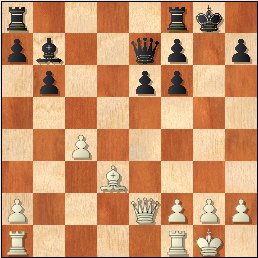 |
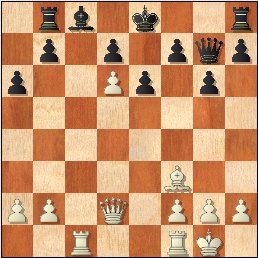 |
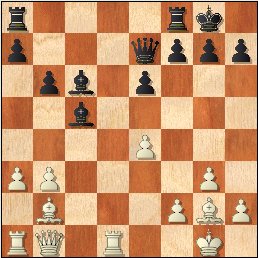 |
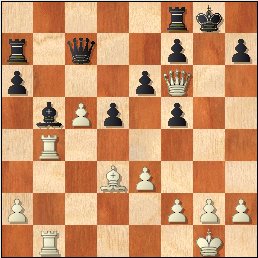 |
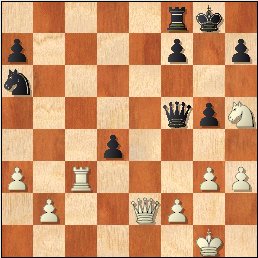 |
|
4-1. White to move |
4-2. White to move | 4-3. White to move | 4-4. White to move | 4-5. White to move |
What is the best move?
STOP - Answers begin below.
4-1. 1.Qg4+ (1.Qh5 f5) Kh8 2.Qh4!, and Black must give up the Q (3...Pf5) to stop 3.Qxh7# Herrmann - Rogmann, 1937
4-2. 1.Qe3! (threatening 2.Qa7) Ra8 2.Qa7!, anyway! and Black must give up the R (2...Rxa7 3.Rxc8#) Romanovsky - Ravinsky, 1943
4-3. 1.Pb4 Bd6 (1...Ba4 was better, but White has big advantage) 2.Qd3 Rad8 (or any other moves to save the d6-B) 3.Qc3. Black can't stop 4.Qxg7# and save the c6-B at the same time Konstantinopolsky - Bivshev, 1952
4-4. 1.Rg4+!! (deflecting the f5-P) Pxg4 2.Qg5+!! (zigzag, 2.Qh6?? Pf5 and Black wins) Kh8 3.Qh6 (attacking the h7-P and the f8-R, both checkmates!). Black resigned Hort - Portisch, 1973
4-5. 1.Qxa6 (ignoring the threat to his R!) dxc 2.Qh6! Qg6 (nothing better) 3.Nf6+, Black resigned. To stop the checkmate (3...Kh8?? 4.Qxf8+) Black must give up the Q (3...Qxf6 4.Qxf6). Next White wins the Black's advanced P. 1:0 Levin,E - Lushenkov,Mikhail, 2010
==============================================================================================
Summary:
I hope that the three examples from the games of my student were interesting and that you like the concept of the zigzagging Q's moves. Also that the additional exercises helped you to reinforce this idea.
==============================================================================================
What do you think about this article? How did you do? For comments,
corrections send email or use
this
form
More on chess training (serious and enlightening) in my books:
|
Special offer: Get all three Chess Exam books autographed and personalized + meet me for 30 min of one-on-one Phone and/or Skype and/or ICC training session for $95 ($125 value), non-US - please add another $35 for shipping with insurance. |
|
|
Chess Exam and Training Guide (2004) |
Copyrighted @ 2010 Igor Khmelnitsky
For comments or permission to reprint please send inquires via email or this form
(*Bonwell, C., & Eison, J. (1991). Active learning: Creating excitement in the classroom (ASHE-ERIC Higher Education Report No. 1). Washington, DC: George Washington University, p. 2)